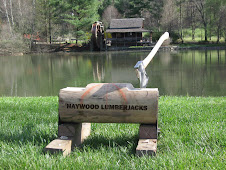
Recent HCC Forest Management Technology graduate Dawn Salley is a news maker! Following her graduation from HCC Dawn took a job with the Cherokee Hotshots. While cleaning up recent storm damage in NYC the New York Times caught her and Matt Gilbert (HCC FMT Class of 2000) in action. GO HAYWOOD! To read the story click on the following:
http://www.nytimes.com/2010/09/28/nyregion/28trees.html
Urban Turn for Workers Accustomed to the ForestBy REBECCA WHITE
An unusual scene unfolded in the rain in Prospect Park on Monday morning, as a crew from Tennessee confronted the aftermath of a particularly turbulent storm.
It was certainly a different sort of emergency for the 21 men and 1 woman in the Cherokee Hotshots, an elite interagency forestry crew that travels the nation, primarily to put out wildfires.
Two tornadoes last week left parks in Queens and Brooklyn with toppled trees, dangling branches and piles of debris crossing pathways. In Prospect Park, 40 trees went down, and almost 130 others were badly damaged.
At a meeting Friday among officials of the United States Forest Service and the city parks department, it was suggested to Adrian Benepe, the parks commissioner, that a specialized — or hotshot — crew come in to help with damage recovery.
“I’d read about how they respond to forest fires,” Mr. Benepe said. “To me, that was something that happens in Yellowstone or the Great Smokies, not New York City.”
Yet the Cherokee Hotshots, based in the Cherokee National Forest in Unicoi, Tenn., made their way to New York City, the first among the 106 interagency hotshot crews to do so since they were formed in the 1940s, said Phil Sammon, a spokesman for the Forest Service.
Members of the crew arrived Sunday in Queens, where they are staying at the Fire Department center in Fort Totten. They drove up from Alabama, where they had spent a week battling a fire over 75 acres of farmland. Their mission here includes Prospect Park in Brooklyn and Kissena Park in Queens.
“We were pretty excited when we heard we were coming to New York,” said Matthew Gilbert, 30, the crew’s superintendent. “This is pretty much a once-in-a-lifetime opportunity.” It was the first time the crew had been assigned a job in a city setting.
Workers started about 9:30 Monday morning, clearing brush and downed trees from pedestrian pathways. Men wielded chain saws with 32-inch bars to dismember trees as old as 75 years, as long as 80 feet and as wide as 40 inches. Some fed smaller tree trunks into a wood chipper; others used axes to drive wedges into trunks before using the chain saws to complete the separation of the trunks into rounds.
They wore protective chaps lined with Kevlar, fire-retardant long-sleeved shirts, leather gloves, white hard hats with full brims — “bigger than construction hats,” one crew member noted — and were equipped with earplugs, radios, “bug eye” protective gear and boots with Vibram soles to provide traction.
In fact, the presence of people in ordinary clothes seemed somewhat disquieting to them.
“We’re used to seeing 10 extra people in a day,” said Brent Foltz, 25, a senior firefighter. “Here, we are seeing 10 extra people in a minute.”
Graham Collins, 29, an artist from Sunset Park, Brooklyn, and his mother, Diana Collins, 61, were just two of the human distractions.
“I like Prospect Park because it’s really a little bit wild anyway,” Mr. Collins said. “It looks like it’s been cleared up really well.” ”
The Prospect Park Alliance intends to replant trees where old ones were destroyed, in accordance with the original design by Frederick Law Olmsted. Since many of the trees that were damaged or killed were large, as many as 10 smaller, younger trees can fill the same area.
“Storms are a natural part of the forest dynamic,” said John Jordan, 41, supervisor of natural resources for the Prospect Park Alliance. “Now dormant seedlings can start growing.”

